Region
Crash of a Swearingen SA227AC Metro III in Oslo
Date & Time:
Mar 2, 2011 at 0905 LT
Registration:
OY-NPB
Survivors:
Yes
Schedule:
Ørland - Oslo
MSN:
AC-420
YOM:
1981
Flight number:
NFA990
Crew on board:
2
Crew fatalities:
Pax on board:
9
Pax fatalities:
Other fatalities:
Total fatalities:
0
Captain / Total hours on type:
2537.00
Copilot / Total hours on type:
1278
Aircraft flight hours:
24833
Aircraft flight cycles:
29491
Circumstances:
After touchdown on runway 19R at Oslo-Gardermoen Airport, while decelerating to a speed of 60 knots, the aircraft deviated to the right. At a speed of 40 knots, it impacted a snow berm then rotated to the right and came to rest in deep snow with its both propellers and the nose damaged. All 11 occupants evacuated safely while the aircraft was considered as damaged beyond repair.
Probable cause:
Comprehensive technical examination of the nose wheel steering on OY-NPB uncovered no single causal factor, but some indications of unsatisfactory maintenance. Irregularities that alone or in combination could have caused a temporary fault with the steering were present. The Accident Investigation Board believes that a temporary fault caused the nose wheel to unintentionally lock itself in a position towards the right. No other defects or irregularities that could explain why the aircraft veered off the runway were found. The AIBN reported that the same fault had occurred 6 days earlier as well, during that encounter the captain managed to disconnect nose wheel steering quickly enough to regain control. Maintenance could not replace the fault and the aircraft was released to service.
Final Report:
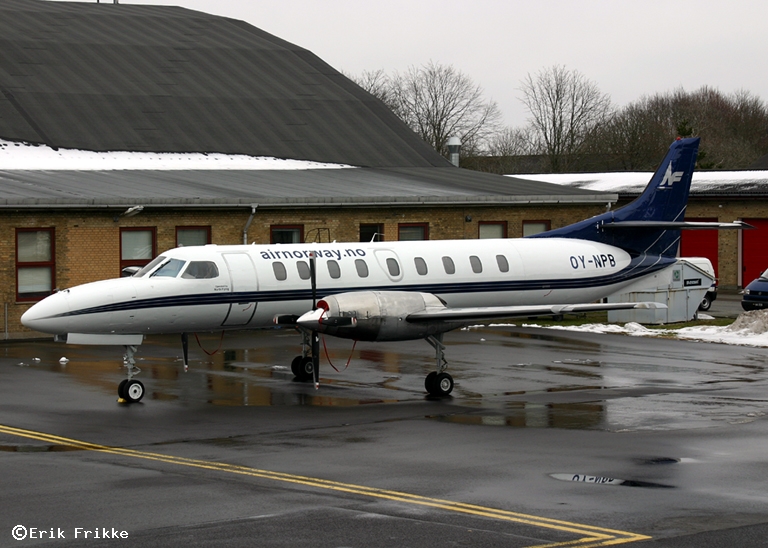
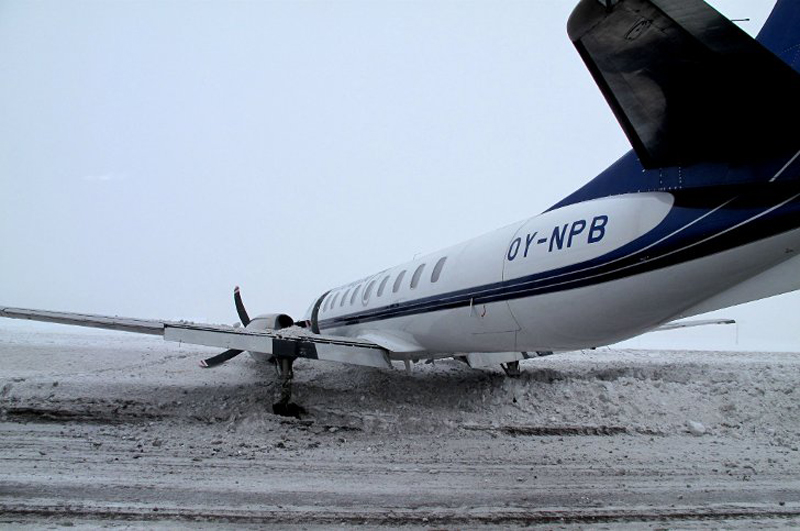
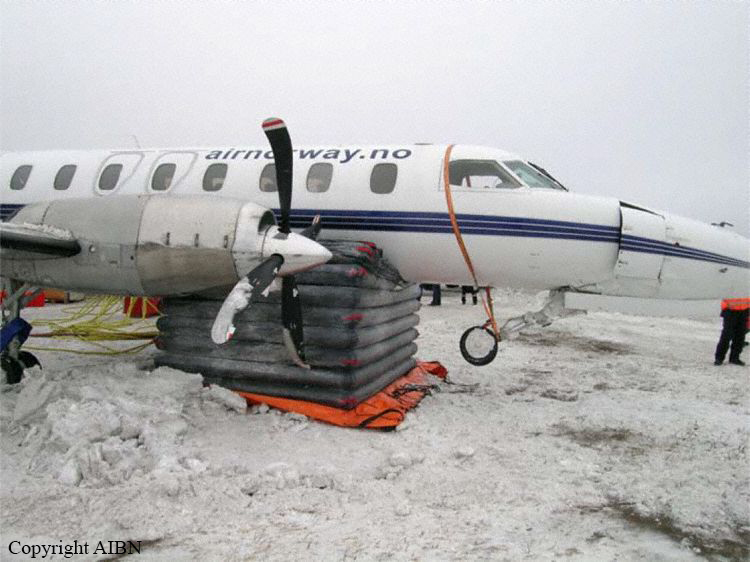
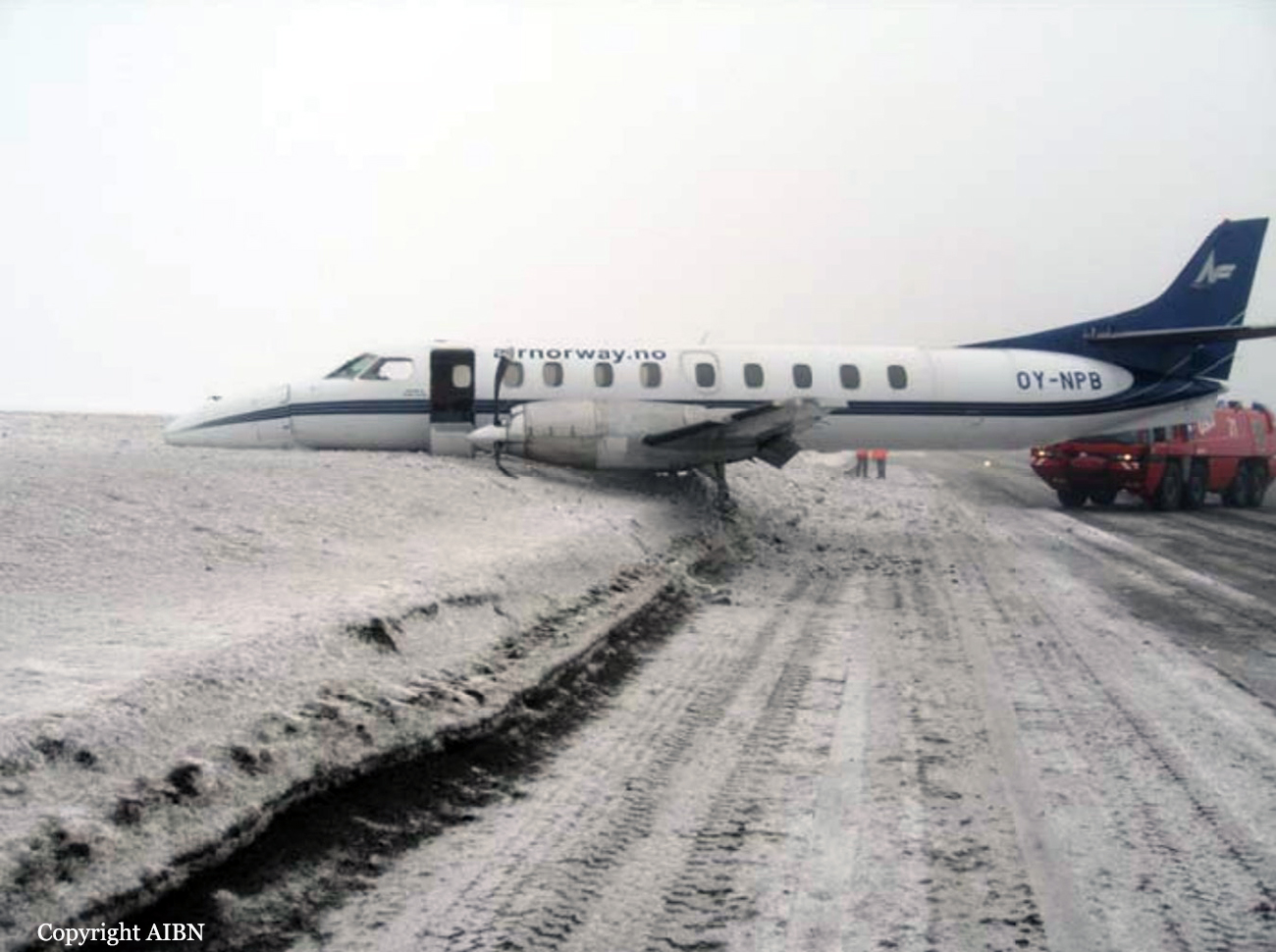
Crash of a Swearingen SA226T Merlin IIIB off Bergen: 3 killed
Date & Time:
Jun 20, 2008 at 1026 LT
Registration:
LN-SFT
Survivors:
No
Schedule:
Bergen - Bergen
MSN:
T-342
YOM:
1980
Crew on board:
3
Crew fatalities:
Pax on board:
0
Pax fatalities:
Other fatalities:
Total fatalities:
3
Captain / Total hours on type:
12000.00
Aircraft flight hours:
13551
Aircraft flight cycles:
5732
Circumstances:
The flight was a skill-test for a candidate that was hired as a first officer on SA226-T(B) Merlins for the operator Helitrans. He was one of two candidates that were employed by the company in early 2008. They underwent ground school and flight training in cooperation with the Swedish Type Rating Training Organisation (TRTO) Trafikkhögskolan. Later it became clear that the Swedish Civil Aviation Authority (CAA) did not accept skill-tests limited to first officer duties on a single pilot certified airplane, as the Norwegian CAA did. The candidates did not possess the skills to act as commanders on the Merlin, and there was a period of uncertainty while the operator and the Norwegian CAA discussed how to conduct the skill-tests, in particular whether to use a simulator or an actual airplane. After several months the issues were resolved and an examiner was appointed. There was a limited slot on a Thursday and a Friday where the examiner, the instructor/commander and the aircraft was available at Bergen Airport Flesland. The first candidate performed the skill-test on Thursday. The weather was not suited for flying skill tests. It was low ceiling, rain showers and winds up to 40 kt and turbulence. Turbulence caused the stick pusher to activate during the demonstration of slow flight. The commander decided to pull the circuit breaker for the Stall Avoidance and Stability Augmentation System (SAS) presumably to avoid nuisance activations of the stick pusher. After the slow flight demonstration, the examiner asked the candidate to demonstrate a stall. The candidate found this exercise frightening as she experienced great difficulties, having to use all her available physical strength to regain normal flight with the engines on full power and in IMC conditions. The weather was similar on Friday with even stronger winds. The SAS circuit breaker was not reset. This was confirmed during the start-up check. The examiner requested a similar program during this skill-test as he did the day before. However, when it came to demonstrating stalls, the examiner asked for a slow flight up to first indication of stall, and not an actual stall. He asked for call outs and a minimum loss of altitude recovery. The commander undertook the tasks of adding power and retracting gear and flaps on the candidate’s request. It was IMC. During this exercise the crew lost control of attitude and airspeed. The stall warning came on, but the airspeed decreased, even with full power applied. Radar data show that the altitude increased 200 – 400 ft during the period where control was lost. Airspeed decreased to about 30 kt and a sink rate of about 10 000 ft/min eventually developed. The airplane hit the sea in a near horizontal attitude about 37 sec. after control was lost. All three on board were fatally injured. The accident aircraft was used for coastguards duties and was modified with external sensors and antennas. The AIBN made a Computational Fluid Dynamics analysis in order to determine whether these installations influenced on stability and flight characteristics in the slow flight and pre-stall regime. It was found that the modifications reduced the overall performance, but did not result in any significant degradation of stability and control in this regime. There was no investigation as to any influence on the characteristics of a fully developed stall. The AIBN is of the opinion that this accident highlights the need for a change in the current training on initial stall recovery techniques, especially the focus on minimum loss of altitude at the expense of breaking the stall by lowering the nose and thus reducing the angle of attack. The AIBN has issued two safety recommendations to the Norwegian CAA; one regarding the conduct of skill-tests for pilots in a multi crew concept on single pilot airplanes, and one suggesting increased focus on flight examiners tasks.
Probable cause:
The following findings were identified:
- Even if the weather on the day of the accident was within the permitted limits, it was not suitable to perform 'airwork' or training exercises,
- The captain thought the weather was not suitable for conducting the skill test for the second candidate. That he nevertheless agreed to take the test may be due to the fact that he felt
a pressure to complete the mission,
- The flight was conducted in challenging conditions and there is reason to believe that atmospheric turbulences may have contributed to the loss of control during the skill flight,
- The flight was completed in clouds, and it can be assumed that the lack of visual references in the clouds contributed to the loss of control.
- Even if the weather on the day of the accident was within the permitted limits, it was not suitable to perform 'airwork' or training exercises,
- The captain thought the weather was not suitable for conducting the skill test for the second candidate. That he nevertheless agreed to take the test may be due to the fact that he felt
a pressure to complete the mission,
- The flight was conducted in challenging conditions and there is reason to believe that atmospheric turbulences may have contributed to the loss of control during the skill flight,
- The flight was completed in clouds, and it can be assumed that the lack of visual references in the clouds contributed to the loss of control.
Final Report:
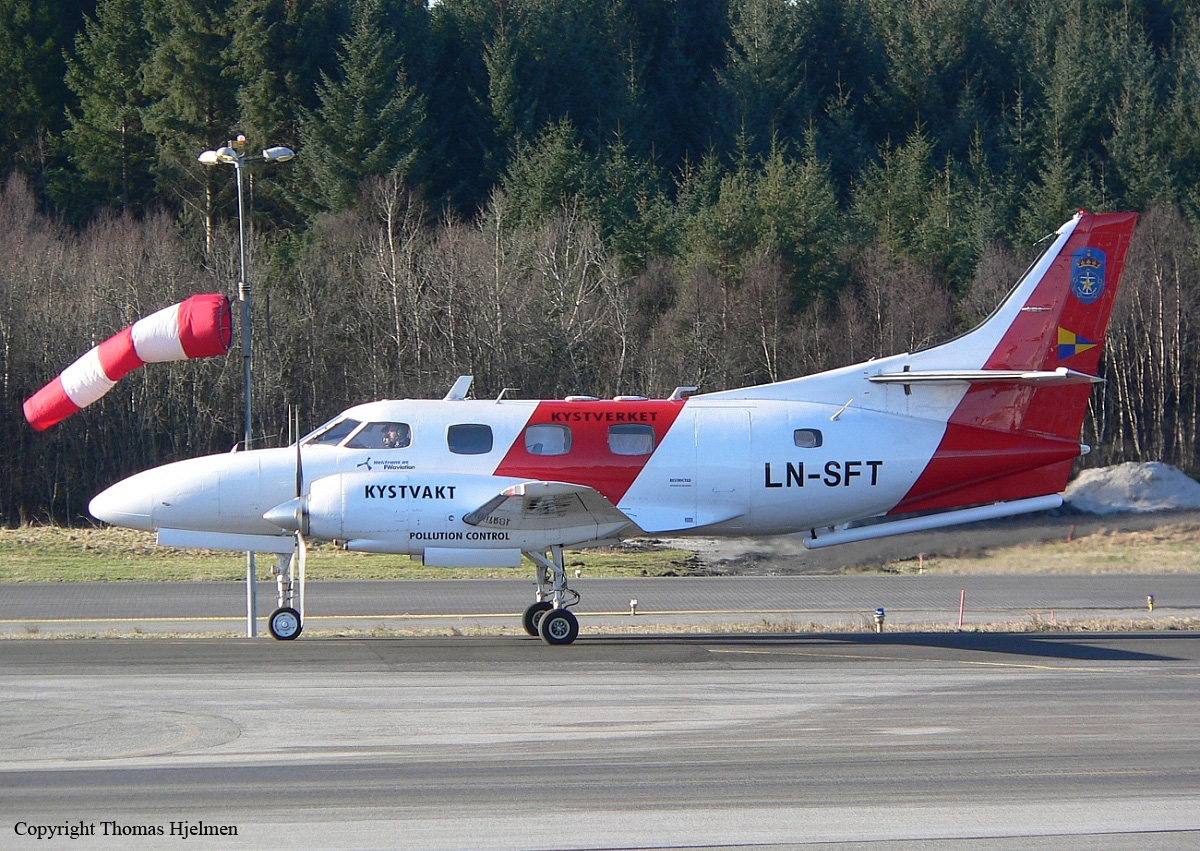


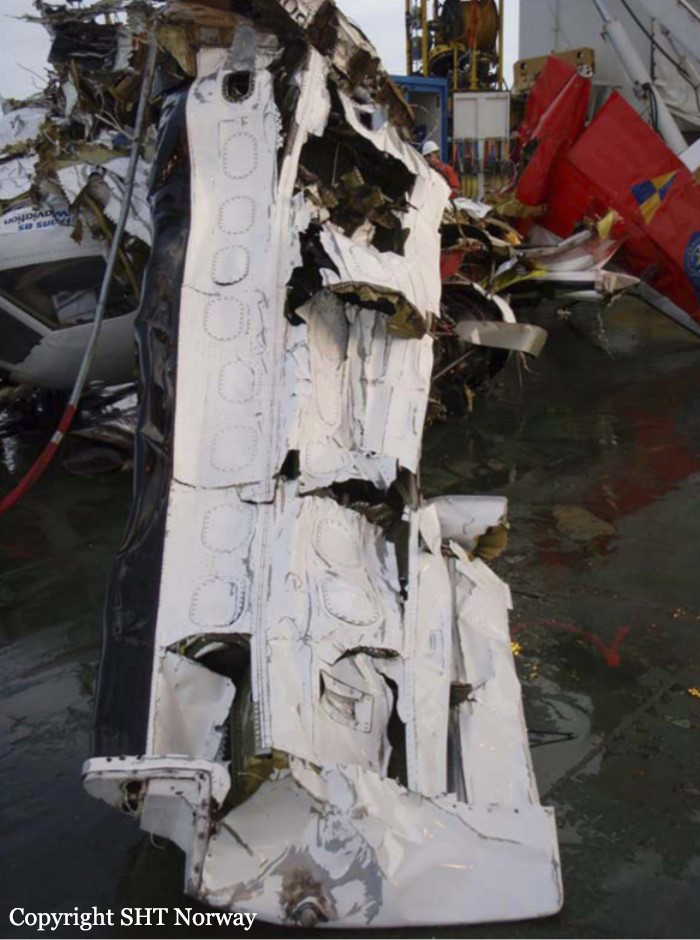
Crash of a BAe 146-200A in Stord: 4 killed
Date & Time:
Oct 10, 2006 at 0732 LT
Registration:
OY-CRG
Survivors:
Yes
Schedule:
Stavanger – Stord – Molde
MSN:
E2075
YOM:
1987
Flight number:
FLI670
Crew on board:
4
Crew fatalities:
Pax on board:
12
Pax fatalities:
Other fatalities:
Total fatalities:
4
Captain / Total hours on type:
1500.00
Copilot / Total hours on type:
250
Aircraft flight hours:
39828
Aircraft flight cycles:
21726
Circumstances:
At 0724 hours, Flesland approach gave clearance for FLI670 to start to descend to 4,000 feet. Three minutes later, it was cleared to leave controlled airspace and transfer to Sørstokken's frequency. In the meantime, the AFIS duty officer at Stord airport had visual contact with the plane and obtained confirmation of its position from Flesland approach. Based on aerodrome data, wind direction and wind speed, temperature and the aircraft's landing weight, the crew found it acceptable to plan for a visual approach and landing on runway 33. This would shorten the approach. They assumed that landing on runway 33 would involve a small tailwind component. The AFIS duty officer was informed of the decision to land on runway 33. The AFIS duty officer confirmed that the wind was 110° 6 kt. When asked, the crew also stated that there were 12 passengers on board. 1.1.6 The approach proceeded as normal. The landing gear was extended and the flaps were extended stepwise. At 07:31:12 hours, the aircraft was 2 NM from the threshold for runway 33 at a height of 800 ft and with a ground speed of 150 kt. The flaps were then extended to 33° and, according to radar data, the ground speed dropped to 130 kt. At 07:31:27 hours, the AFIS duty officer repeated the 'runway free' message and described the wind as 120° 6 kt. The cockpit voice recorder (CVR) tells us that at 07:31:43 hours the first officer then confirmed that the plane was stabilised and held a speed of plus 5 (kt). Six seconds later, the first officer announced that the speed was plus 3 (kt). At 07:31:51 hours, the CVR recorded that a warning sound (ping) was emitted by the aircraft's audible warning Accident Investigation Board Norway system. The commander later told AIBN that he aimed for three red and one white on the PAPI (Precision approach path indicator). The first officer then announced twice that the speed was correct (bug speed). From the aircraft cockpit voice recorder (CVR) it is documented that the pilots kept a speed over threshold at Vref. According to the aircraft flight manual (AFM) correct airspeed is Vref =112 kt. According to data from the ground radar the aircraft's ground speed was 120 kt on passing the threshold for runway 33. The flight commander has stated that when the aircraft was approximately 50 ft above the runway, he lowered the thrust levers as normal to the 'Flight Idle' position. At 07:32:14 hours, sounds from the CVR indicated that the wheels touched the runway. Both pilots have stated that the landing took place a few metres beyond the standard landing point, and that it was a ‘soft’ landing. Next, the following occurred (times are stated in seconds
after nose wheel touchdown):
- 1 second: 'and spoilers' announced by first officer
- 1.5 seconds: sound of spoiler lever being moved to aft position (LIFT SPLR)
- 4 seconds: 'no spoilers' announced by first officer (standard phrase in accordance with the airline's standard operating procedures (SOP) when spoiler indicator lights does not come on)
- 6.6 seconds: sound of brake selector switch being turned
- 7.9 seconds: audio signal (single chime) from the aircraft's warning system
- 12.8 seconds: The first screeching noises from the tyres are audible
- 12.8 – 22.8 seconds: Varying degrees of screeching noises from the tyres can be heard
- 22.8 seconds: The aircraft leaves the runway, at the same time as the AFIS duty officer activates the crash alarm.
- 26 seconds: The cockpit voice recorder stops recording sound.
The first officer has informed the AIBN that, after landing, he verified that the commander moved the thrust levers from 'Flight Idle' to 'Ground Idle', at the same time as the nose of the aircraft was lowered. He also saw that the commander moved the spoiler lever from 'AIR BRAKE' (air brake fully engaged) to 'LIFT SPLR' (spoilers deployed). The first officer expected the two spoiler indicator lights (SPLR Y and SPLR G, see section 1.6.6.3) to come on after approximately three seconds. He was therefore surprised when this did not happen. In accordance with the airline's procedures, the first officer then verified, among other things, that hydraulic pressure and other instruments showed normal values and that the switches in question were set to the correct positions. The commander has explained to the AIBN that, when the speed had dropped to approximately 80 kt, he kept his left hand on the nose wheel steering and his right hand on the thrust levers. The first officer then took over the control wheel. The commander has stated that he felt that the brakes were working until they were about half way down the runway, after which the expected retardation did not occur. The aircraft had then got so far down the runway that it was too late to abort the landing. The commander applied full force on both brake pedals, without achieving a normal braking action. In an attempt to improve retardation he moved the brake selector lever from the 'Green' position to the 'Yellow' position, but this did not help. He then moved the lever to the 'Emergency Brake' position, whereby the aircraft's anti-skid system was disconnected. At that point the commander realised that it was impossible to stop the aircraft, even by continuously applying full pressure on the brake pedals, and that the aircraft would probably run off the runway. He considered that it was not advisable to let the aircraft run off the runway towards the steep area to the left of the aircraft or towards the rocks on the right. His local knowledge told him that the best alternative was therefore to steer the aircraft towards the end of the runway. In a last attempt to stop the aircraft, he steered it towards the right half of the runway and then manoeuvred it with the intent to skid sideways towards the left. The commander hoped that skidding would increase friction and hopefully help to reduce the speed of the aircraft. The aircraft left the runway in a skid a few metres to the left of the centerline. The commander believed that he would have been able to stop the aircraft had the runway been longer by approximately 50-100 metres. The first officer believed that the aircraft had a speed of approximately 5-10 km/h when it left the edge and that they would have been able to stop had the runway been 10-15 metres longer. The AFIS duty officer has stated that he followed OY-CRG visually during parts of the approach and landing. He believed that the aircraft may have flown a little higher and faster than normal during the final approach. The duty officer was not quite sure about where the aircraft touched down, but he estimated that it was within the first third of the runway. For a moment during the rollout OY-CRG was obscured for the AFIS duty officer behind an aircraft of the same type (OY-RCW) from Atlantic Airways that was parked at the apron (see Figure 2). When the AFIS duty officer again got the aircraft in sight, he realised that something was not right. The aircraft had a greater speed than normal. He saw that the aircraft towards the end turned into the right half and then turned back towards the left half of the runway. The duty officer observed the plane leave the runway in a skid at approximately 45° in relation to the runway direction. The duty officer immediately triggered the crash alarm. The AFIS duty officer has stated that the speed of the aircraft was moderate enough for him to hope for a while that it would be able to stop before reaching the end of the runway. He suggested that the aircraft would perhaps have been able to stop had the runway been another 50 metres long. He felt that it was unreal when the aircraft's tail fin moved high into the air and he witnessed the aircraft disappear off the end of the runway. The AFIS duty officer had previously seen blue smoke coming from the main wheels of other aircraft of the same type during braking. He observed a great deal of dampness and smoke emanating from the back of the main wheels of OY-CRG during rollout. The spray, which was about 30% higher than the top of the main wheels, appeared to form a triangle behind the wheels. The spray was of a white colour, extended considerably higher than during previous landings and continued along the length of the runway. He did not register whether the aircraft's spoilers were deployed or not, but he saw that the aircraft continued to produce wake vortices during rollout. When smoke started rising from the crash site, he saw that the fire crews were already on their way. In accordance with procedure, the fire and rescue service at Stord airport are on standby beside the fire engines when aircraft take off and land at the airport. The duty officer and three firemen were therefore in position at the fire station and observed the landing. The duty officer believed that the aircraft touched down in the standard place, possibly a little further along the runway than usual. Everything appeared to be normal until an estimated five to ten seconds after touchdown, when they noticed that the speed of the aircraft was higher than usual. When OY-CRG passed the taxiway to the south, the duty officer and firefighter n°1 both heard that the aircraft was beginning to brake heavy, because of the extremely loud noises emitted by the aircraft’s tyres and brakes. The duty officer had heard similar noises on some other occasions, but only for a second or two as aircraft were brought to a full stop or passed painted areas of the runway. In the case of OY-CRG the noises were persistent. They also observed that the wings continued to produce wake vortices during rollout, something they had not seen before. They realised that the aircraft would need assistance and prepared to respond. The last that the duty officer saw of the aircraft was when it skidded with its nose pointing an estimated 45° towards the left and banked violently to the right as it left the runway. In his opinion, the speed of the aircraft at that point was approximately 30-70 km/h (16-38 kt). When the aircraft disappeared over the edge of the runway and the crash alarm was activated, the airport's two fire engines were on their way to the site. The passengers interviewed by the AIBN provided varying descriptions of the approach and landing, but none of them noticed any braking action after touchdown. All the passengers have confirmed that the aircraft swayed from side to side when nearing the end of the runway. They heard the 'screeching' of brakes and the aircraft turned leftwards. One person observed blue smoke coming from the wheels. One person believed that one of the engines on the left increased its speed. Most passengers felt that the speed was relatively low when the aircraft tipped over the edge of the runway. The cabin crew seated at the back of the cabin have stated that the flight proceeded as usual until the landing at Stord airport, apart from the fact that, shortly before landing, she heard a relatively loud whistling noise. She said that she has heard similar noises during other flights, but not so loud. She assumed that the noise came from the seal around the door to her left. She did not otherwise register anything out of the ordinary until the aircraft left the runway.
after nose wheel touchdown):
- 1 second: 'and spoilers' announced by first officer
- 1.5 seconds: sound of spoiler lever being moved to aft position (LIFT SPLR)
- 4 seconds: 'no spoilers' announced by first officer (standard phrase in accordance with the airline's standard operating procedures (SOP) when spoiler indicator lights does not come on)
- 6.6 seconds: sound of brake selector switch being turned
- 7.9 seconds: audio signal (single chime) from the aircraft's warning system
- 12.8 seconds: The first screeching noises from the tyres are audible
- 12.8 – 22.8 seconds: Varying degrees of screeching noises from the tyres can be heard
- 22.8 seconds: The aircraft leaves the runway, at the same time as the AFIS duty officer activates the crash alarm.
- 26 seconds: The cockpit voice recorder stops recording sound.
The first officer has informed the AIBN that, after landing, he verified that the commander moved the thrust levers from 'Flight Idle' to 'Ground Idle', at the same time as the nose of the aircraft was lowered. He also saw that the commander moved the spoiler lever from 'AIR BRAKE' (air brake fully engaged) to 'LIFT SPLR' (spoilers deployed). The first officer expected the two spoiler indicator lights (SPLR Y and SPLR G, see section 1.6.6.3) to come on after approximately three seconds. He was therefore surprised when this did not happen. In accordance with the airline's procedures, the first officer then verified, among other things, that hydraulic pressure and other instruments showed normal values and that the switches in question were set to the correct positions. The commander has explained to the AIBN that, when the speed had dropped to approximately 80 kt, he kept his left hand on the nose wheel steering and his right hand on the thrust levers. The first officer then took over the control wheel. The commander has stated that he felt that the brakes were working until they were about half way down the runway, after which the expected retardation did not occur. The aircraft had then got so far down the runway that it was too late to abort the landing. The commander applied full force on both brake pedals, without achieving a normal braking action. In an attempt to improve retardation he moved the brake selector lever from the 'Green' position to the 'Yellow' position, but this did not help. He then moved the lever to the 'Emergency Brake' position, whereby the aircraft's anti-skid system was disconnected. At that point the commander realised that it was impossible to stop the aircraft, even by continuously applying full pressure on the brake pedals, and that the aircraft would probably run off the runway. He considered that it was not advisable to let the aircraft run off the runway towards the steep area to the left of the aircraft or towards the rocks on the right. His local knowledge told him that the best alternative was therefore to steer the aircraft towards the end of the runway. In a last attempt to stop the aircraft, he steered it towards the right half of the runway and then manoeuvred it with the intent to skid sideways towards the left. The commander hoped that skidding would increase friction and hopefully help to reduce the speed of the aircraft. The aircraft left the runway in a skid a few metres to the left of the centerline. The commander believed that he would have been able to stop the aircraft had the runway been longer by approximately 50-100 metres. The first officer believed that the aircraft had a speed of approximately 5-10 km/h when it left the edge and that they would have been able to stop had the runway been 10-15 metres longer. The AFIS duty officer has stated that he followed OY-CRG visually during parts of the approach and landing. He believed that the aircraft may have flown a little higher and faster than normal during the final approach. The duty officer was not quite sure about where the aircraft touched down, but he estimated that it was within the first third of the runway. For a moment during the rollout OY-CRG was obscured for the AFIS duty officer behind an aircraft of the same type (OY-RCW) from Atlantic Airways that was parked at the apron (see Figure 2). When the AFIS duty officer again got the aircraft in sight, he realised that something was not right. The aircraft had a greater speed than normal. He saw that the aircraft towards the end turned into the right half and then turned back towards the left half of the runway. The duty officer observed the plane leave the runway in a skid at approximately 45° in relation to the runway direction. The duty officer immediately triggered the crash alarm. The AFIS duty officer has stated that the speed of the aircraft was moderate enough for him to hope for a while that it would be able to stop before reaching the end of the runway. He suggested that the aircraft would perhaps have been able to stop had the runway been another 50 metres long. He felt that it was unreal when the aircraft's tail fin moved high into the air and he witnessed the aircraft disappear off the end of the runway. The AFIS duty officer had previously seen blue smoke coming from the main wheels of other aircraft of the same type during braking. He observed a great deal of dampness and smoke emanating from the back of the main wheels of OY-CRG during rollout. The spray, which was about 30% higher than the top of the main wheels, appeared to form a triangle behind the wheels. The spray was of a white colour, extended considerably higher than during previous landings and continued along the length of the runway. He did not register whether the aircraft's spoilers were deployed or not, but he saw that the aircraft continued to produce wake vortices during rollout. When smoke started rising from the crash site, he saw that the fire crews were already on their way. In accordance with procedure, the fire and rescue service at Stord airport are on standby beside the fire engines when aircraft take off and land at the airport. The duty officer and three firemen were therefore in position at the fire station and observed the landing. The duty officer believed that the aircraft touched down in the standard place, possibly a little further along the runway than usual. Everything appeared to be normal until an estimated five to ten seconds after touchdown, when they noticed that the speed of the aircraft was higher than usual. When OY-CRG passed the taxiway to the south, the duty officer and firefighter n°1 both heard that the aircraft was beginning to brake heavy, because of the extremely loud noises emitted by the aircraft’s tyres and brakes. The duty officer had heard similar noises on some other occasions, but only for a second or two as aircraft were brought to a full stop or passed painted areas of the runway. In the case of OY-CRG the noises were persistent. They also observed that the wings continued to produce wake vortices during rollout, something they had not seen before. They realised that the aircraft would need assistance and prepared to respond. The last that the duty officer saw of the aircraft was when it skidded with its nose pointing an estimated 45° towards the left and banked violently to the right as it left the runway. In his opinion, the speed of the aircraft at that point was approximately 30-70 km/h (16-38 kt). When the aircraft disappeared over the edge of the runway and the crash alarm was activated, the airport's two fire engines were on their way to the site. The passengers interviewed by the AIBN provided varying descriptions of the approach and landing, but none of them noticed any braking action after touchdown. All the passengers have confirmed that the aircraft swayed from side to side when nearing the end of the runway. They heard the 'screeching' of brakes and the aircraft turned leftwards. One person observed blue smoke coming from the wheels. One person believed that one of the engines on the left increased its speed. Most passengers felt that the speed was relatively low when the aircraft tipped over the edge of the runway. The cabin crew seated at the back of the cabin have stated that the flight proceeded as usual until the landing at Stord airport, apart from the fact that, shortly before landing, she heard a relatively loud whistling noise. She said that she has heard similar noises during other flights, but not so loud. She assumed that the noise came from the seal around the door to her left. She did not otherwise register anything out of the ordinary until the aircraft left the runway.
Probable cause:
The AIBN sees this accident as the accumulated effect of three factors – the aircraft design, the airport and operational factors, which, seen as a whole, may have been unacceptable at the time of the accident.
The accident:
a) The approach and landing were normal, within those variations that may be expected.
b) None of the aircraft's six lift spoilers were deployed when the commander operated the spoiler lever.
c) The AIBN has found two possible explanations for the spoilers not being deployed:
1. A mechanical fault in the spoiler lever mechanism.
2. Faults in two of the four thrust lever micro switches. A fault in one switch may have been hidden right up until a further switch failed.
d) The crew received a warning that the spoilers were not deployed.
e) The commander noticed that the aircraft was not decelerating as expected. He did not associate this with the fault in the spoilers and assumed that the problem was due to a fault in the brakes. He therefore applied the emergency brakes.
f) The emergency brakes do not have anti-skid protection and the wheels locked, so that in combination with the damp runway reverted rubber hydroplaning occurred. Consequently the friction against the runway was significantly reduced.
g) The runway was not grooved. The AIBN believes that reverted rubber hydroplaning will not occur, or will be significantly reduced, on grooved runways.
h) The aircraft was travelling at approximately 15-20 kt when it left the runway and slid down the slope.
i) The AIBN considers that, on its own, the failure of the spoilers to extend would not have caused a runway overrun. The aircraft might have stopped within the landing distance available with a good margin if optimum braking had been used.
j) The aircraft sustained serious damage as a result of the uneven terrain and the abrupt stop at the bottom of the slope.
The fire:
a) The aircraft was seriously damaged during the excursion, so that fuel leakage and immediate ignition occurred, most probably due to an electrical short circuit.
b) The fire escalated rapidly, because it was supplied with large quantities of fuel from the tanks in the aircraft's wings.
c) The inner left engine continued to run at high speed for more than five minutes after the aircraft crashed. This set the surrounding air in motion, so that the fire received a good supply of oxygen.
Survival aspects:
a) The AIBN considers that, in principle, all those involved had a chance of surviving the accident resulting from the excursion.
b) Flames spread to the cabin after a very short time.
c) The rapid spread and intensity of the fire left very short time margins during the evacuation.
d) The survivors evacuated via the left cockpit window and the left rear door. The other doors could not be opened or could not be used as a result of the fire.
e) The reinforced cockpit door prevented evacuation via the cockpit. Two persons were found dead in the cabin, behind this door.
f) The fire and rescue service were quick to arrive at the end of the runway.
g) The fire engines did not come near enough to the fire due to the difficult terrain.
h) The jet blast from the running engine was directed towards the fire engines, creating a headwind.
i) Even though the fire and rescue service did all they could to contain the accident, the result was that the effort had little effect in the most critical period when the evacuation was in progress.
The accident:
a) The approach and landing were normal, within those variations that may be expected.
b) None of the aircraft's six lift spoilers were deployed when the commander operated the spoiler lever.
c) The AIBN has found two possible explanations for the spoilers not being deployed:
1. A mechanical fault in the spoiler lever mechanism.
2. Faults in two of the four thrust lever micro switches. A fault in one switch may have been hidden right up until a further switch failed.
d) The crew received a warning that the spoilers were not deployed.
e) The commander noticed that the aircraft was not decelerating as expected. He did not associate this with the fault in the spoilers and assumed that the problem was due to a fault in the brakes. He therefore applied the emergency brakes.
f) The emergency brakes do not have anti-skid protection and the wheels locked, so that in combination with the damp runway reverted rubber hydroplaning occurred. Consequently the friction against the runway was significantly reduced.
g) The runway was not grooved. The AIBN believes that reverted rubber hydroplaning will not occur, or will be significantly reduced, on grooved runways.
h) The aircraft was travelling at approximately 15-20 kt when it left the runway and slid down the slope.
i) The AIBN considers that, on its own, the failure of the spoilers to extend would not have caused a runway overrun. The aircraft might have stopped within the landing distance available with a good margin if optimum braking had been used.
j) The aircraft sustained serious damage as a result of the uneven terrain and the abrupt stop at the bottom of the slope.
The fire:
a) The aircraft was seriously damaged during the excursion, so that fuel leakage and immediate ignition occurred, most probably due to an electrical short circuit.
b) The fire escalated rapidly, because it was supplied with large quantities of fuel from the tanks in the aircraft's wings.
c) The inner left engine continued to run at high speed for more than five minutes after the aircraft crashed. This set the surrounding air in motion, so that the fire received a good supply of oxygen.
Survival aspects:
a) The AIBN considers that, in principle, all those involved had a chance of surviving the accident resulting from the excursion.
b) Flames spread to the cabin after a very short time.
c) The rapid spread and intensity of the fire left very short time margins during the evacuation.
d) The survivors evacuated via the left cockpit window and the left rear door. The other doors could not be opened or could not be used as a result of the fire.
e) The reinforced cockpit door prevented evacuation via the cockpit. Two persons were found dead in the cabin, behind this door.
f) The fire and rescue service were quick to arrive at the end of the runway.
g) The fire engines did not come near enough to the fire due to the difficult terrain.
h) The jet blast from the running engine was directed towards the fire engines, creating a headwind.
i) Even though the fire and rescue service did all they could to contain the accident, the result was that the effort had little effect in the most critical period when the evacuation was in progress.
Final Report:
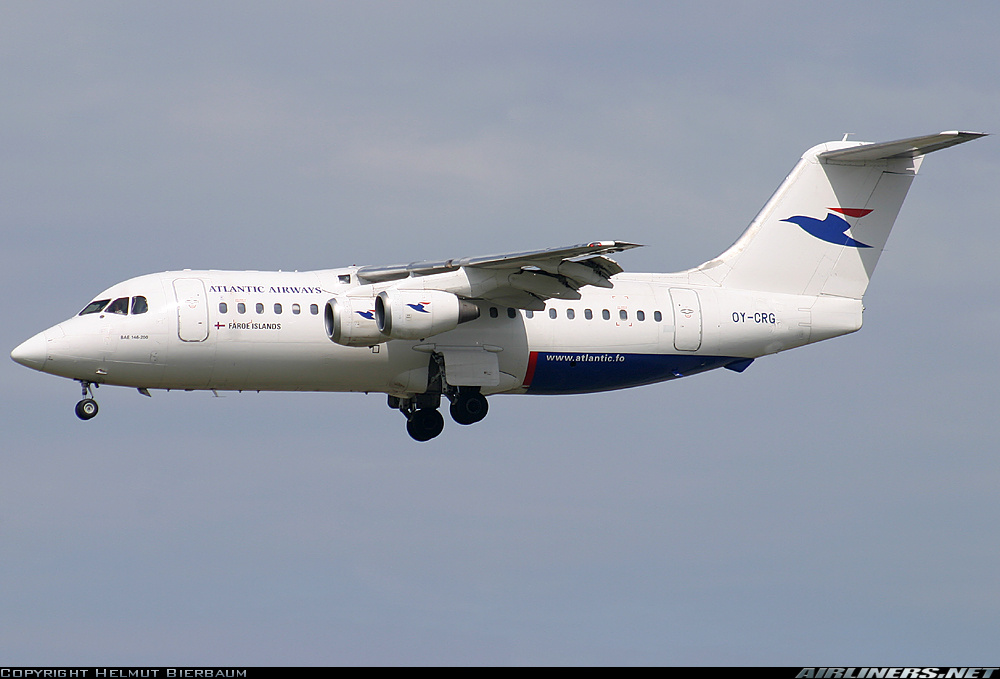
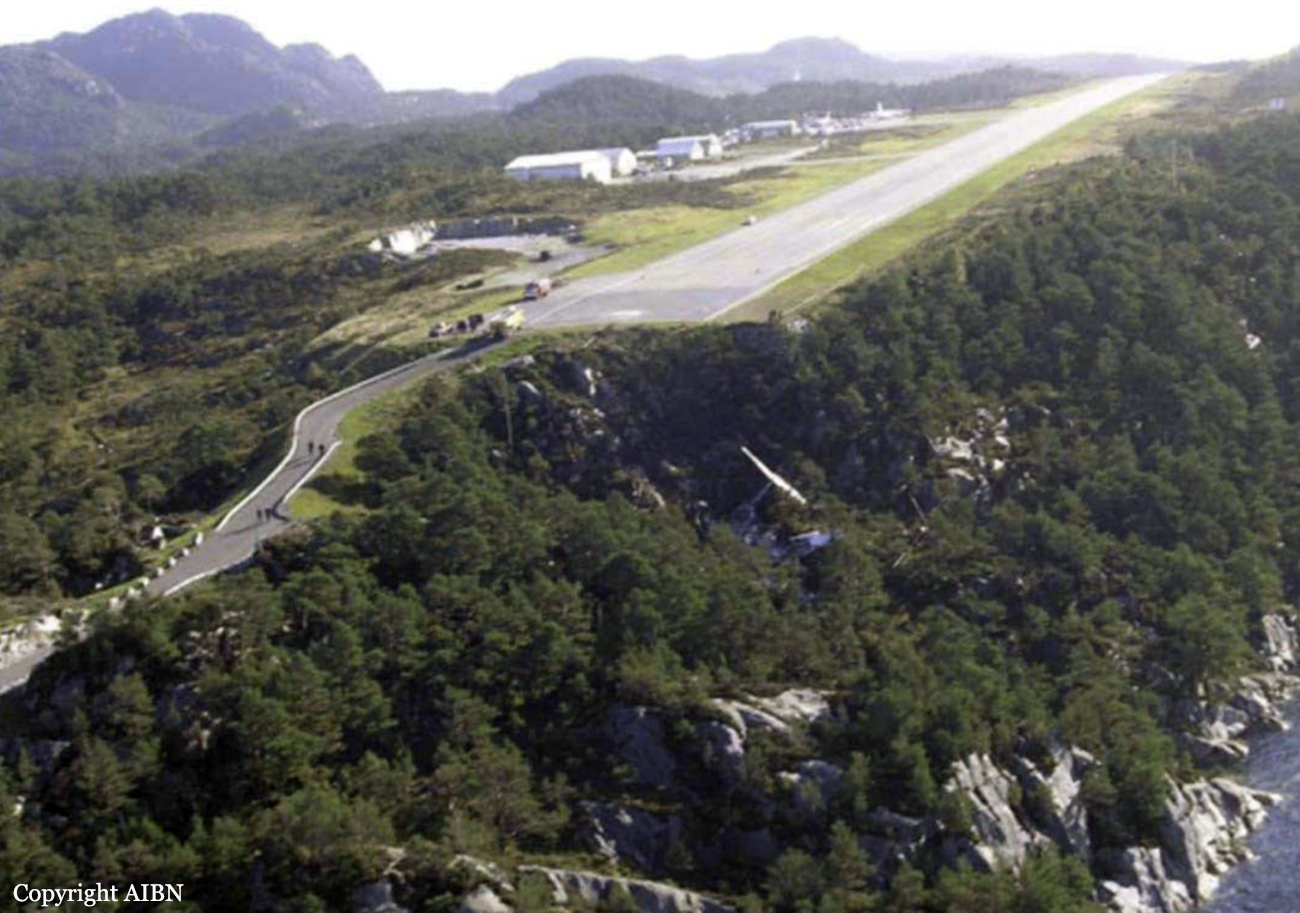
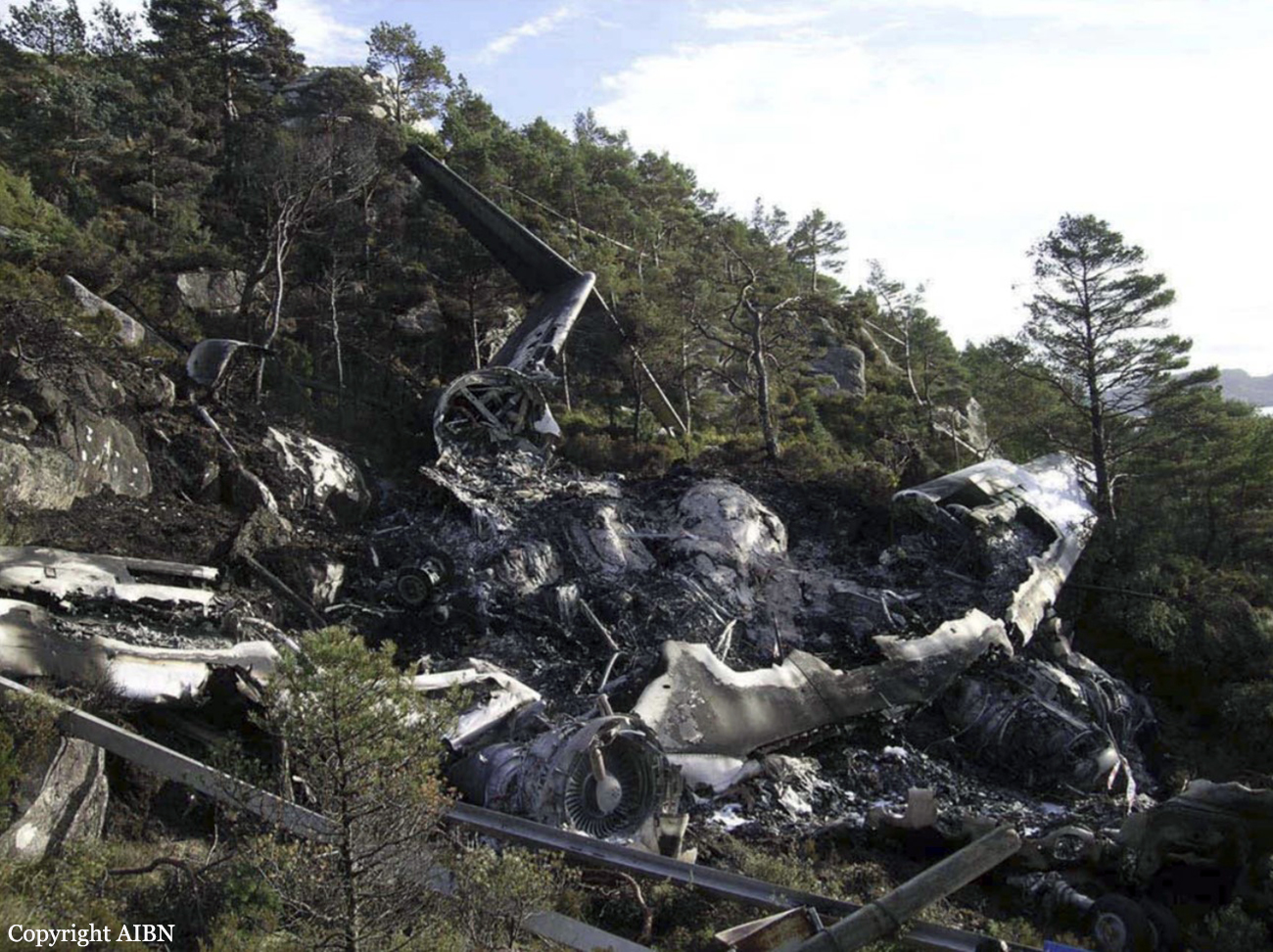

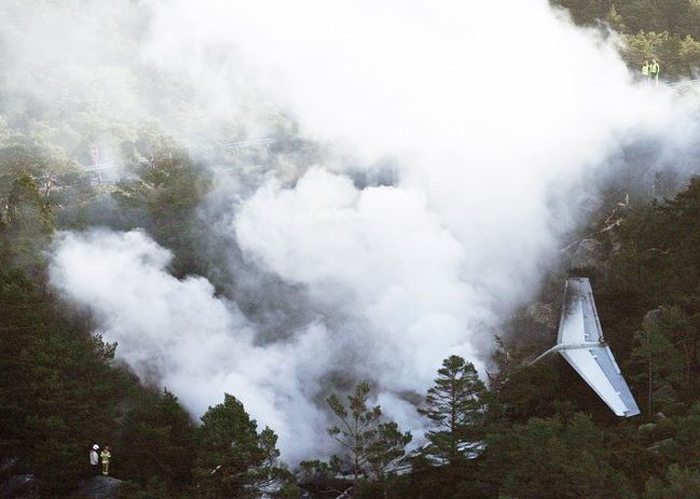

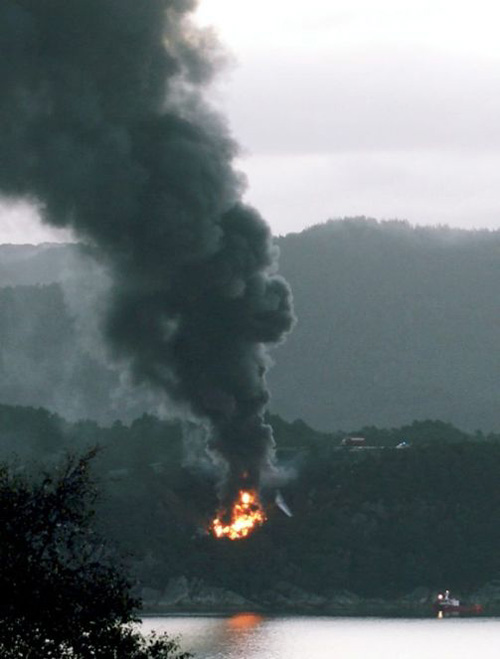



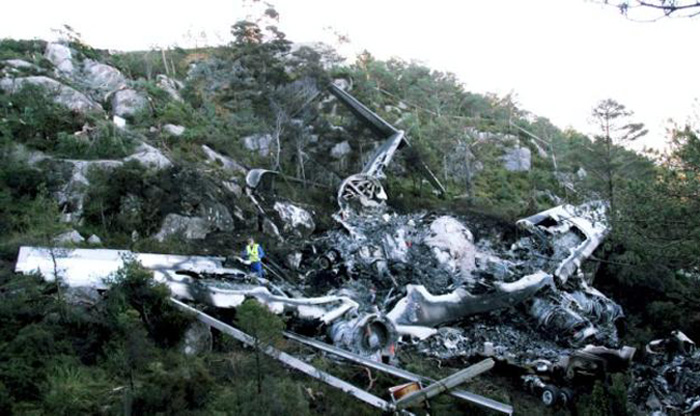
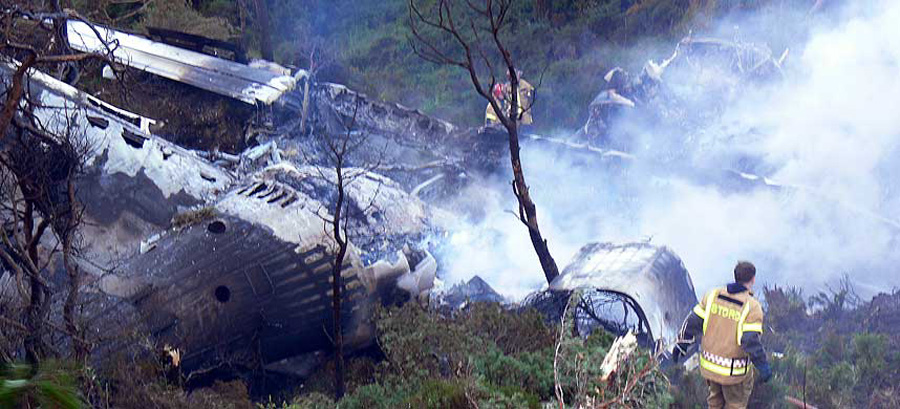
Crash of a De Havilland DHC-8-103 in Hammerfest
Date & Time:
May 1, 2005 at 1436 LT
Registration:
LN-WIK
Survivors:
Yes
Schedule:
Tromsø – Hammerfest
MSN:
394
YOM:
1995
Flight number:
WF921
Crew on board:
3
Crew fatalities:
Pax on board:
27
Pax fatalities:
Other fatalities:
Total fatalities:
0
Captain / Total hours on type:
5500.00
Copilot / Total hours on type:
60
Aircraft flight hours:
20462
Aircraft flight cycles:
42997
Circumstances:
Widerøe flight WIF 921 took off from Tromsø airport (ENTC) at time 1401 with an estimated landing time at Hammerfest airport (ENHF) 1442. On board the aircraft, a DHC-8-103 with registration LN-WIK, were a crew of two pilots and one cabin attendant, 26 fare paying passengers and one passive cabin attendant. The crew had taken off from ENHF earlier in the day, when the weather and wind did not cause any problems. During the approach to ENHF the crew was informed about variable and occasional gusty wind from south-east. The wind direction favoured runway 23 and the crew planned the landing accordingly. The copilot was Pilot Flying (PF) and the commander was Pilot Not Flying (PNF). The copilot was newly hired and was flying under supervision. The crew was kept updated on the wind conditions by the AFIS operator, and at times the gusty wind conditions favoured runway 05. The copilot left the control to the commander who continued the approach to runway 05. Just before landing the wind direction veered to the right and increased in strength, resulting in a significant tail wind component. This resulted in a marked increase in the descent rate which the commander tried to stop by advancing to full power. However, the altitude was too low and the airplane touched down hard just inside the runway edge on runway 05. At touch down the right main landing gear leg failed. The airplane slid on the belly, right partly retracted main wheel and wing tip for some 650 m, and stopped just after the second (TWY B) turnoff to the apron. The fire and rescue vehicles were quickly at the scene and sprayed foam on the plane to prevent fire. The cabin attendant calmed the passengers who wanted to get out of the plane quickly due to smoke and burned smell in the cabin. It took 33 seconds from the commander ordered evacuation until this was initiated. The delay was mainly caused by the fact that the order did not get through the cabin’s Public Address (PA) system.
Probable cause:
The investigations show that Widerøe permitted landings in up to the maximum demonstrated crosswind component of 36 kt and in up to 10 kt tail wind during short field operations. AIBN recommends that Widerøe should review the wind limitations and prohibit tail wind component during landings on short runways in conditions with large variations in wind direction and strength. AIBN is issuing 7 safety recommendations.
Final Report:
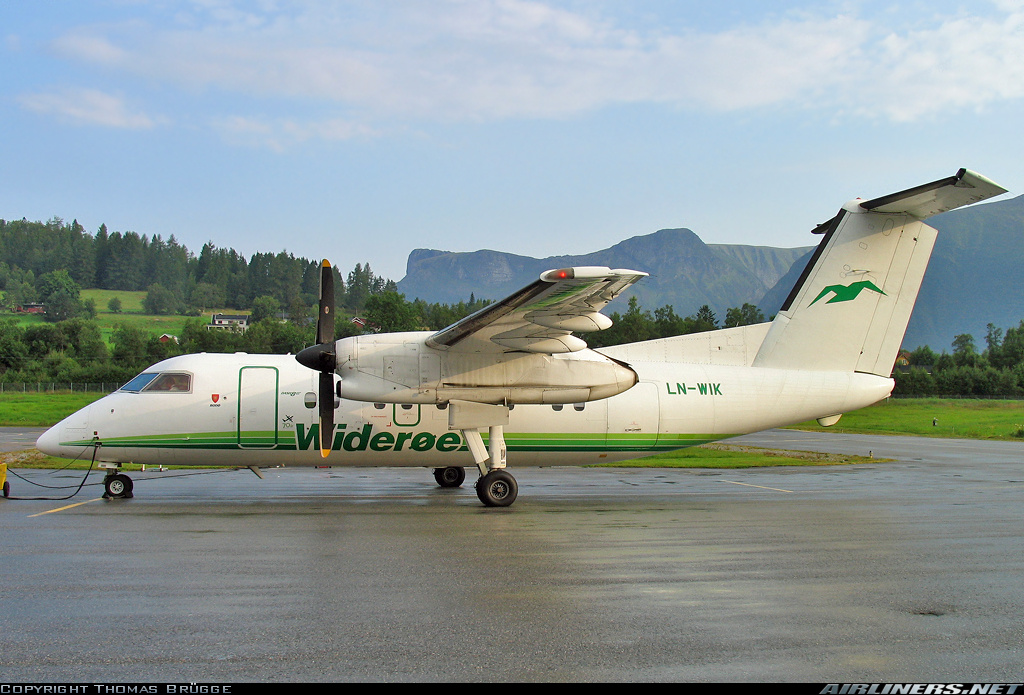
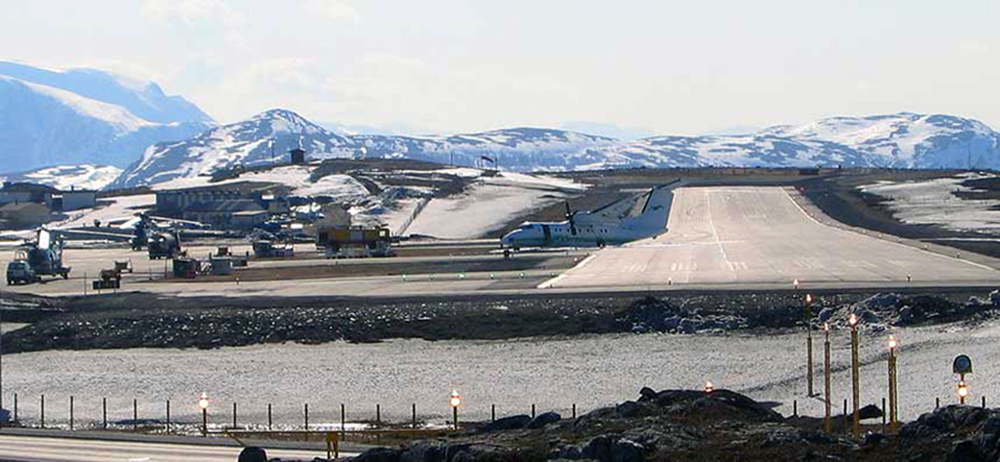

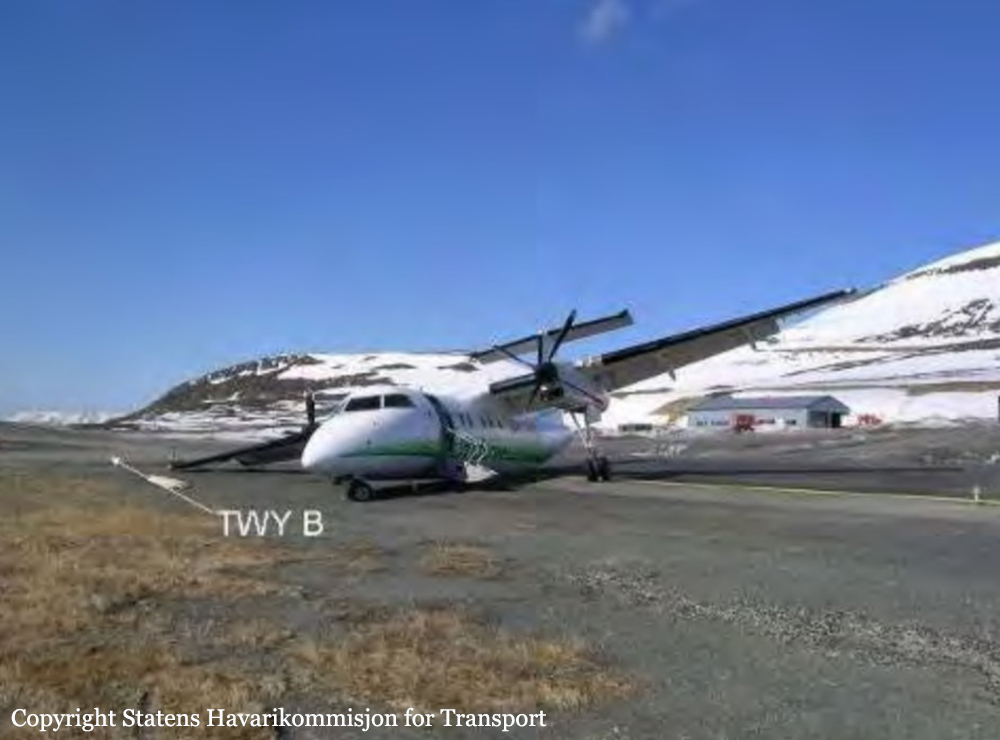
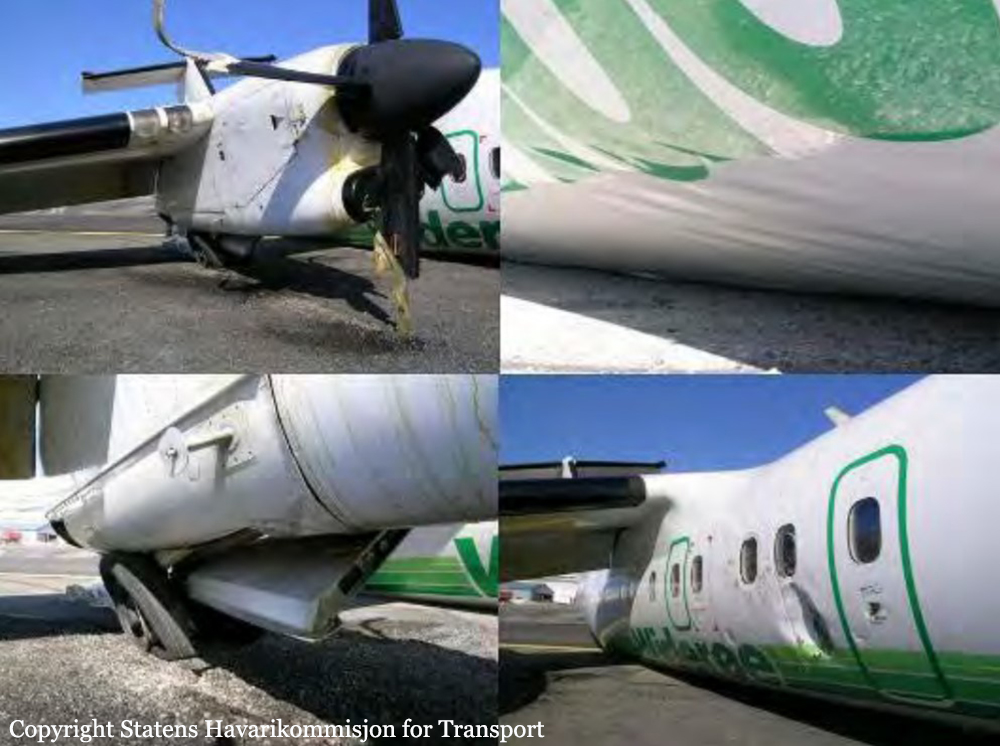

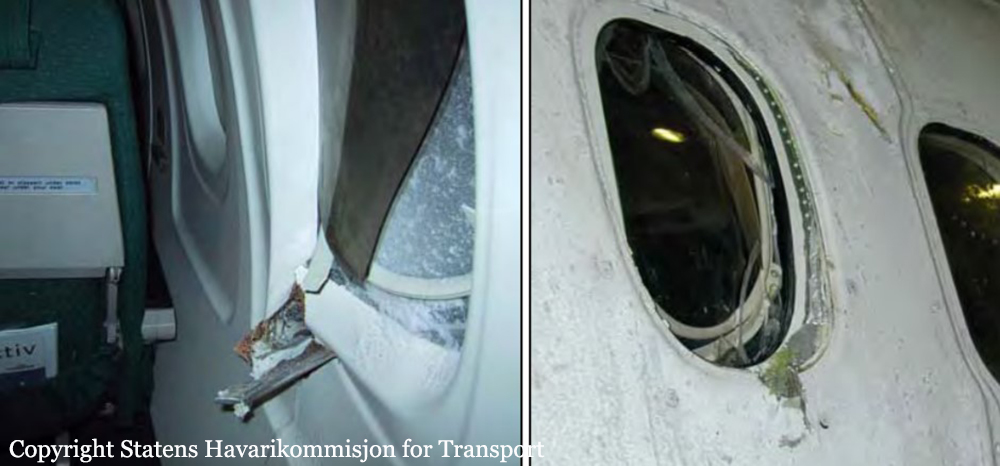
Crash of a PZL-Mielec AN-28 in Østre Æra
Date & Time:
Jul 16, 2004 at 1324 LT
Registration:
YL-KAB
Survivors:
Yes
Schedule:
Østre Æra - Østre Æra
MSN:
1AJ009-15
YOM:
1991
Crew on board:
2
Crew fatalities:
Pax on board:
0
Pax fatalities:
Other fatalities:
Total fatalities:
0
Captain / Total hours on type:
400.00
Copilot / Total hours on type:
1000
Circumstances:
Two aircraft of type AN-28, operated by Rigas Aeroklubs Latvia, were dropping parachutists at the National Parachute Sport Centre, Østre Æra airstrip in Østerdalen. The company had had a great deal of experience with this type of operations, and had been carrying out parachute drops in Norway each summer for the last 9 years. They had brought their own licensed aircraft technicians with them to Østre Æra. On Friday morning, 16 July 2004, the weather conditions were good when the flights started. The crew of YL-KAB, which comprised two experienced pilots, were rested after a normal night's sleep. They first performed six routine drop flights. After stopping to fill up with fuel, normal preparations were made for the next flight with 20 parachutists who were to jump in two groups of 10. The seventh departure was carried out at time 1305. The Commander asked for and was given clearance by the air traffic control service to climb to flight level FL150 (15,000 ft equivalent to approx. 4,500 metres). The parachutists were then dropped from that altitude. The first drop of 10 parachutists was made on a southerly course above the airstrip, and the aircraft continued on that course for a short time before turning through 180° and getting ready for the next drop at the same location on a northerly course. A large cumulonimbus cloud (CB), with precipitation, had approached the airfield from the north at this time. To reach the drop zone above the runway, the aircraft had to fly close to this cloud. The aircraft was not equipped with weather radar. The last parachutists to leave the aircraft were in a tandem jump that was being filmed on video. The film showed that the parachutists became covered in a layer of white ice within 2-3 seconds of leaving the aircraft. The ice on the parachutists only thawed once they had descended to lower altitudes where the air temperature was above zero. Once the parachutists had jumped, the aircraft was positioned close to the CB cloud at a low cruising speed. They were exposed to moderate turbulence from the cloud. The Commander, who was the PF (pilot flying), started a sudden 90° turn to the left while also reducing engine power to flight idle in order to avoid the CB cloud and return to Østre Æra to land. At this point, the First Officer who was PNF (pilot not flying) observed that ice had formed on the front windshield, and he chose to switch on the anti-icing system. He did this without informing the PF. A few seconds later both engines stopped, and both propellers automatically adopted the feathered position. The pilots had not noticed any technical problems with the aircraft engines before they failed. During the descent, the PNF, on the PF's orders, carried out a series of start-up attempts with reference to the checklist/procedure they had available in the cockpit. The engines would not start and the PF made a decision and prepared to carry out an emergency landing at Østre Æra without engines. The runway at Østre Æra is 600 m long and 10 m wide. The surrounding area is covered by dense coniferous forest and they had no alternative landing areas within reach. Because they were without engine power, there was no hydraulic power to operate the aircraft's flaps. This meant that the speed of the aircraft had to be kept relatively high, approx. 160-180 km/h. The final approach was further complicated because the PF had to avoid the last 10 parachutists who were still in the air and who were steering towards a landing area just beside the airstrip. The PF first positioned the aircraft on downwind on a southerly course west of the airfield, in order then to make a left turn to final on runway 01. The landing took place around halfway down the runway, at a faster speed than normal - according to the Commander's explanation approximately 160-170 km/h. The PF braked using the wheel brakes, but when he realized that he would not be able to stop on the length of runway remaining, he ceased braking. He knew that the terrain directly on the extension to the runway was rough, and chose to use the aircraft's remaining speed to lift it off the ground and to alter course a little to the right. The aircraft passed over the approx. 2.5 m high embankment in the transition between the runway level and the higher marshy plateau surrounding the northern runway area, see Figure 1. The aircraft ran approx. 230 m in ground effect before landing on its heels in the flat marshy area north of the airfield. After around 60 m of roll-out, the nose wheel and the aircraft's nose struck a ditch and the aircraft turned over lengthways. It came to rest upside down with its nose section pointing towards the landing strip.
Probable cause:
The experienced Commander assessed the distance to the cumulonimbus cloud as sufficient to allow the drop to be carried out, and expected that they would then rapidly make their way out of the exposed area. It appeared, however, that problems arose when the aircraft was exposed to turbulence and icing from the cloud. The AIBN believes the limits of the engines' operational range were exceeded since the anti-icing system was switched on while the power output from the engines was low, in combination with low airspeed, turbulence and sudden manoeuvring. At that, both engines stopped, and the propellers were automatically feathered. The AIBN believes the engines would not restart because the Feathering Levers were not moved from the forward to the rear position and forward again, as is required after automatic feathering. The manufacturer has pointed out that, according to the procedures, the crew should have refrained from restart attempts and prioritized preparing for the emergency landing. AIBN acknowledges this view, taken into consideration that the crew had not received necessary training and that no suitable checklists existed. On the other hand, it is the AIBN’s opinion that this strategy may appear too passive in a real emergency. If the flight is over rugged mountain terrain or over water, an emergency landing may have fatal outcome. Provided there is sufficient time, and that crew cooperation is organised in such a way that it does not jeopardise the conduct of safe flight, a successful restart may prevent an accident. The AIBN cannot rule out the possibility that the crew's ability to make a correct assessment of the situation was reduced due to oxygen deficiency. Low oxygen-saturation in the brain would first lead to generally reduced mental capacity. In particular, this applies to the capacity to do several things simultaneously and the ability to remember. These are factors that are crucial when a pilot in a stressful situation has to choose the best solution to a problem, and the negative effects will appear more rapidly the older a person is. The fact that the First Officer switched on the anti-icing system without asking the Commander first, indicates that crew collaboration was not functioning at its best. The AIBN believes that the crew, after having entered this difficult situation, carried out a satisfactory emergency landing under very demanding conditions. The fact of the parachutists being within the approach sector made the scenario more complex, and a landing ahead of the threshold had to be avoided. With the flaps non-functional, it is understandable that the speed was high and the touchdown point not optimal. The fact that the Commander got the aircraft into the air again and landed on the higher marshy plateau, was probably crucial to the outcome. Continued braking would have resulted in the aircraft running into the earth embankment at relatively high residual speed, and it is doubtful whether the crew would have survived. A safety recommendation is being put forward in connection with this. Even if allowances are made for parachuting being a special type of operation that often takes place under the direction of a club, the AIBN believes that this investigation has uncovered several issues that cannot be considered to be satisfactory when compared to the safety standard on which they ought to be based. A user-friendly checklist system in the cockpit which is used during normal operations, in emergency situations and during flight training would increase the probability of the aircraft being operated in accordance with the manufacturer's recommendations. It is of great importance that pilots are sufficiently trained and experienced to carry out appropriate emergency procedures. It is assumed, however, that the new regulation concerning civil parachute jumping will contribute to increased levels of safety, and the AIBN sees no need to recommend any further measures.
Final Report:


Crash of a Dornier DO228-202 in Bodø
Date & Time:
Dec 4, 2003 at 0909 LT
Registration:
LN-HTA
Survivors:
Yes
Schedule:
Røst – Bodø
MSN:
8127
YOM:
1987
Flight number:
KAT603
Crew on board:
2
Crew fatalities:
Pax on board:
2
Pax fatalities:
Other fatalities:
Total fatalities:
0
Captain / Total hours on type:
700.00
Copilot / Total hours on type:
260
Aircraft flight hours:
11069
Circumstances:
Kato Airline flight KAT603, an aircraft of the type Dornier 228-202 with registration LN-HTA, was to fly a regular scheduled flight from Røst airport (ENRS) to Bodø airport (ENBO). There were two passengers and two pilots on board. There was a strong westerly wind, and when the plane approached Bodø extensive lightning activity developed quickly. The aircraft was struck by a very powerful lightning. The lightning struck the aircraft’s nose area and passed to the tail. Boundings between the fuselage and tail surface and a wire between the tail surface and the elevator were burned off. A powerful electric energy passed through the elevator rod in the tail section. A rod end came loose, resulting in a breach in the control rod. Thus the only connection between the control column in the cockpit and the elevator was lost. This aircraft type has electric pitch trim which adjusts the tail surface angle of attack and after a period the pilots regained limited control of the aircraft’s nose position by using this. When the lightning struck the aircraft, the pilots were blinded for approximately 30 seconds. They lost control of the aircraft for a period and the aircraft came very close to stalling. The pilots declared an emergency. The aircraft’s remaining systems were intact and the pilots succeeded in bringing the plane in for landing. During the first landing attempt the airspeed was somewhat high. The aircraft hit the ground in an approximate three-point position and bounced into the air. The pilots concluded that the landing was uncontrollable because the elevator was not working. The landing was aborted and the aircraft circled for a new attempt. Wind conditions were difficult and the next attempt was also unstable in terms of height and speed. At short final the aircraft nosed down and the pilots barely managed to flare a little before the aircraft hit the ground. The point of impact was a few metres before the runway and the aircraft slid onto the runway. Emergency services quickly arrived at the scene. The two pilots were seriously injured while both passengers suffered only minor physical injuries. No fuel leakage or fire occurred. The aircraft was written off.
Probable cause:
Significant investigation results:
a) The air traffic control service did not have equipment for integrated weather presentation on the radar display.
b) The aircraft’s weather radar did not indicate precipitation cells and was therefore not functioning correctly.
c) Up to 30% of the wires on individual bondings between the fuselage, horizontal stabilizer and elevator may have been broken before the lightning struck.
d) The aircraft was hit by lightning containing a very large amount of energy. The aircraft’s bondings were not able to conduct the electric energy from the lightning and the transfer rod from the cockpit to the elevator was broken.
e) As a result of the reduced control of the aircraft’s pitch and difficult wind conditions, the sink rate was not sufficiently stabilized on short final. The crew were unable to prevent the aircraft from hitting the ground.
a) The air traffic control service did not have equipment for integrated weather presentation on the radar display.
b) The aircraft’s weather radar did not indicate precipitation cells and was therefore not functioning correctly.
c) Up to 30% of the wires on individual bondings between the fuselage, horizontal stabilizer and elevator may have been broken before the lightning struck.
d) The aircraft was hit by lightning containing a very large amount of energy. The aircraft’s bondings were not able to conduct the electric energy from the lightning and the transfer rod from the cockpit to the elevator was broken.
e) As a result of the reduced control of the aircraft’s pitch and difficult wind conditions, the sink rate was not sufficiently stabilized on short final. The crew were unable to prevent the aircraft from hitting the ground.
Final Report:

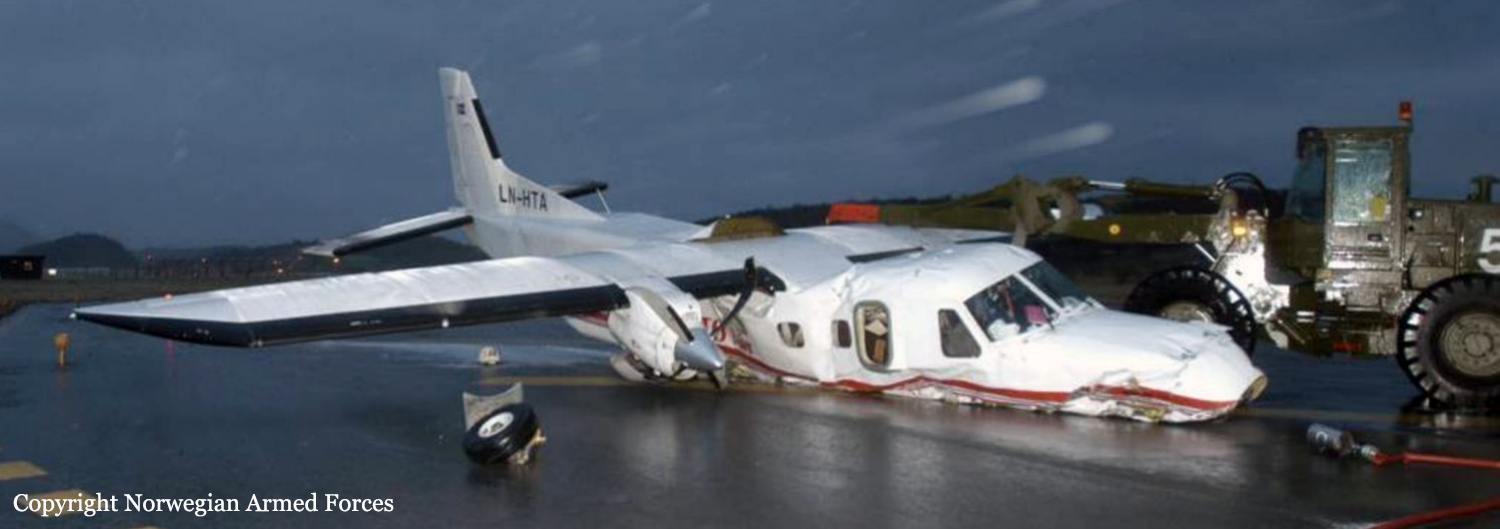
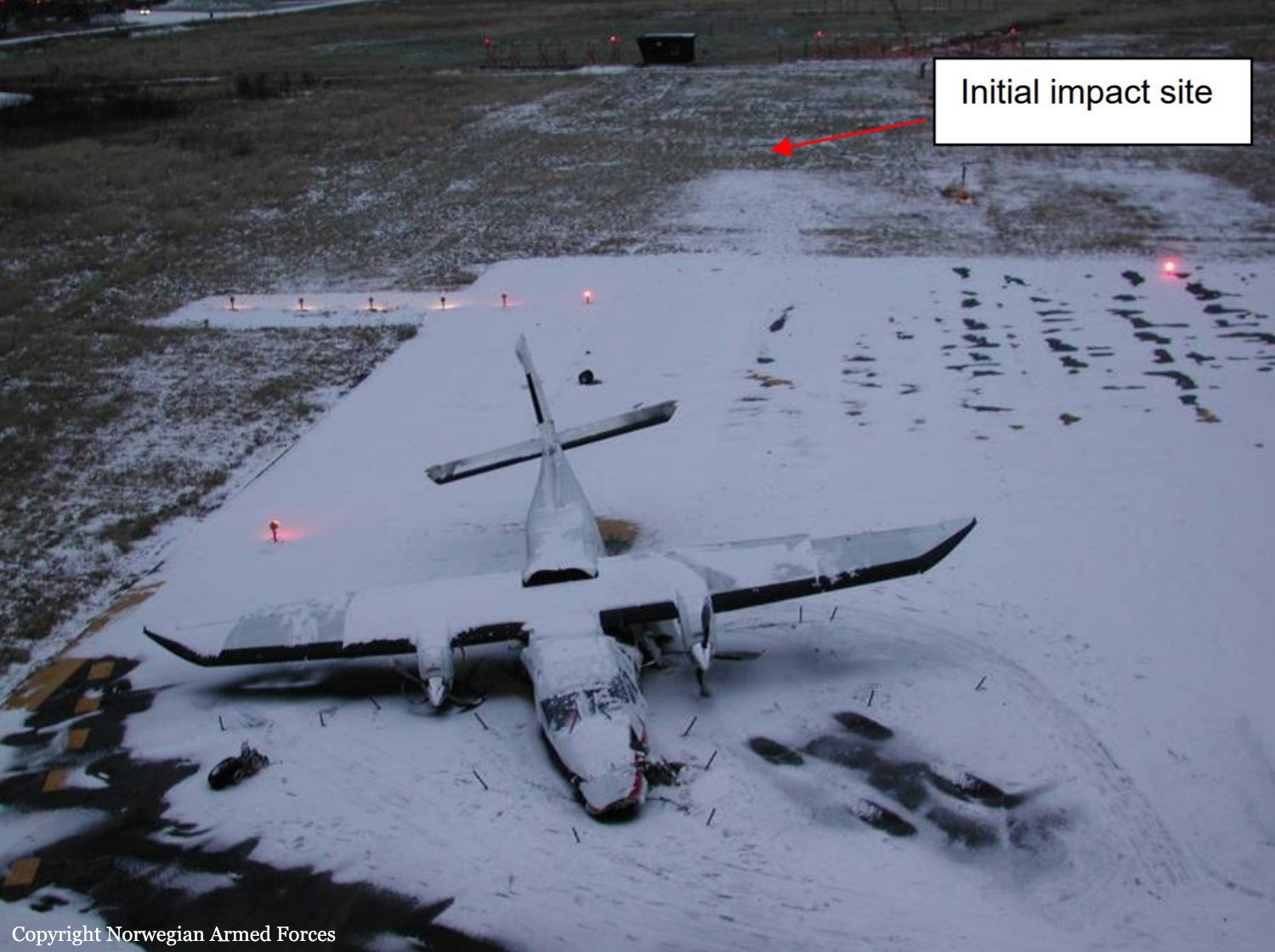
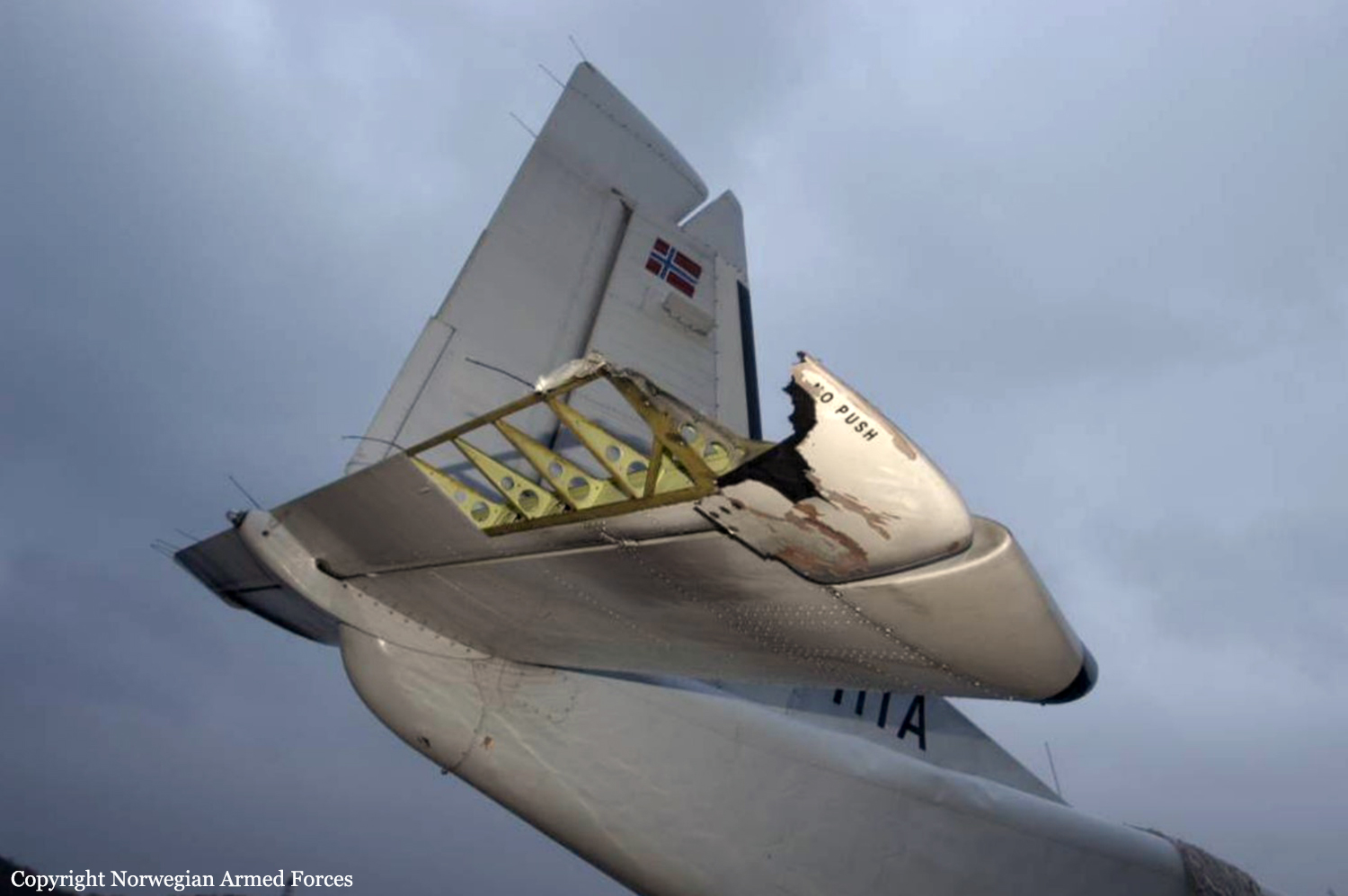

Crash of a BAe 3101 Jetstream 31 in Skien
Date & Time:
Nov 30, 2001 at 1828 LT
Registration:
SE-LGA
Survivors:
Yes
Schedule:
Bergen - Skien
MSN:
636
YOM:
1984
Flight number:
EXC204
Crew on board:
2
Crew fatalities:
Pax on board:
11
Pax fatalities:
Other fatalities:
Total fatalities:
0
Captain / Total hours on type:
600.00
Copilot / Total hours on type:
390
Aircraft flight hours:
14074
Aircraft flight cycles:
16666
Circumstances:
The aircraft was on its way to Skien with a crew of two and 11 passengers. During the flight, ice was observed on the aircraft’s wings, but the ice was considered to be too thin to be removed. During descent towards runway 19 at Geiteryggen the aircraft’s ground proximity warning system (GPWS) sounded a total of three times. The aircraft was then in clouds and the crew did not have visual contact with the ground. The warnings, combined with somewhat poorly functioning crew coordination, resulted in the crew forgetting to actuate the system for removing ice from the wings. The subsequent landing at 1828 hrs was unusually hard, and several of the passengers thought that the aircraft fell the last few metres onto the runway. The hard landing caused permanent deformation of the left wing so that the left-hand landing gear was knocked out of position, and the left propeller grounded on the runway. The crew lost directional control and the aircraft skewed to the left and ran off the runway. The aircraft then hit a gravel bank 371 metres from the touchdown point. The collision with the gravel bank was so hard that the crew and several of the passengers were injured and the aircraft was a total loss. It was dark, light rain and 4 °C at Geiteryggen when the accident occurred. The wind was stated to be 120° 10 kt. The investigation shows that it is probable that ice on the wings was the initiating factor for the accident. The AIBN has not formed an opinion on whether the ice resulted in the high sink rate after the first officer reduced the power output of the engines, or whether the aircraft stalled before it hit the runway. Investigation has to a large extend focused on the crew composition and training. A systematic investigation of the organisation has also taken place. In the opinion of the AIBN, the company has principally based its operations on minimum standards, and this has resulted in a number of weaknesses in organisation, procedures and quality assurance. These conditions have indirectly led to the company operating the route Skien – Bergen with a crew that, at times, did not maintain the standard that is expected for scheduled passenger flights. The investigation has also revealed that procedures for de-icing of the aircraft wings could be improved.
Probable cause:
Significant investigation results:
a) The decision was made to wait to remove the ice from the wings because, according to the SOP, it should only be removed if it had been “typically half an inch on the leading edge”. This postponement was a contributory factor in the ice being forgotten.
b) At times, the relationship between the flight crew members was very tense during the approach to Skien. This led to a breakdown in crew coordination.
c) Among the consequences of the warnings from the GPWS was a very high workload for the crew. In combination with the defective crew coordination, this contributed to the ice on the wings being forgotten.
d) It is probable that the aircraft hit the runway with great force because the wings were contaminated with ice. The AIBN is not forming a final opinion on whether the wings stalled, whether the aircraft developed a high sink rate due to ice accretion or whether the hard landing was due to a combination of the two explanatory models.
e) The company could only provide documentary evidence to show that the Commander had attended an absolute minimum of training after being employed within the company. Parts of the mandatory training had taken place by means of self-study without any form of formal verification of achievement of results.
f) The company’s operation was largely based on minimum solutions. This reduced the safety margins within company operations.
g) The company’s quality system contributed little to ensuring ‘Safe Operational Practices’ in the company.
h) Authority inspection of the company was deficient.
a) The decision was made to wait to remove the ice from the wings because, according to the SOP, it should only be removed if it had been “typically half an inch on the leading edge”. This postponement was a contributory factor in the ice being forgotten.
b) At times, the relationship between the flight crew members was very tense during the approach to Skien. This led to a breakdown in crew coordination.
c) Among the consequences of the warnings from the GPWS was a very high workload for the crew. In combination with the defective crew coordination, this contributed to the ice on the wings being forgotten.
d) It is probable that the aircraft hit the runway with great force because the wings were contaminated with ice. The AIBN is not forming a final opinion on whether the wings stalled, whether the aircraft developed a high sink rate due to ice accretion or whether the hard landing was due to a combination of the two explanatory models.
e) The company could only provide documentary evidence to show that the Commander had attended an absolute minimum of training after being employed within the company. Parts of the mandatory training had taken place by means of self-study without any form of formal verification of achievement of results.
f) The company’s operation was largely based on minimum solutions. This reduced the safety margins within company operations.
g) The company’s quality system contributed little to ensuring ‘Safe Operational Practices’ in the company.
h) Authority inspection of the company was deficient.
Final Report:
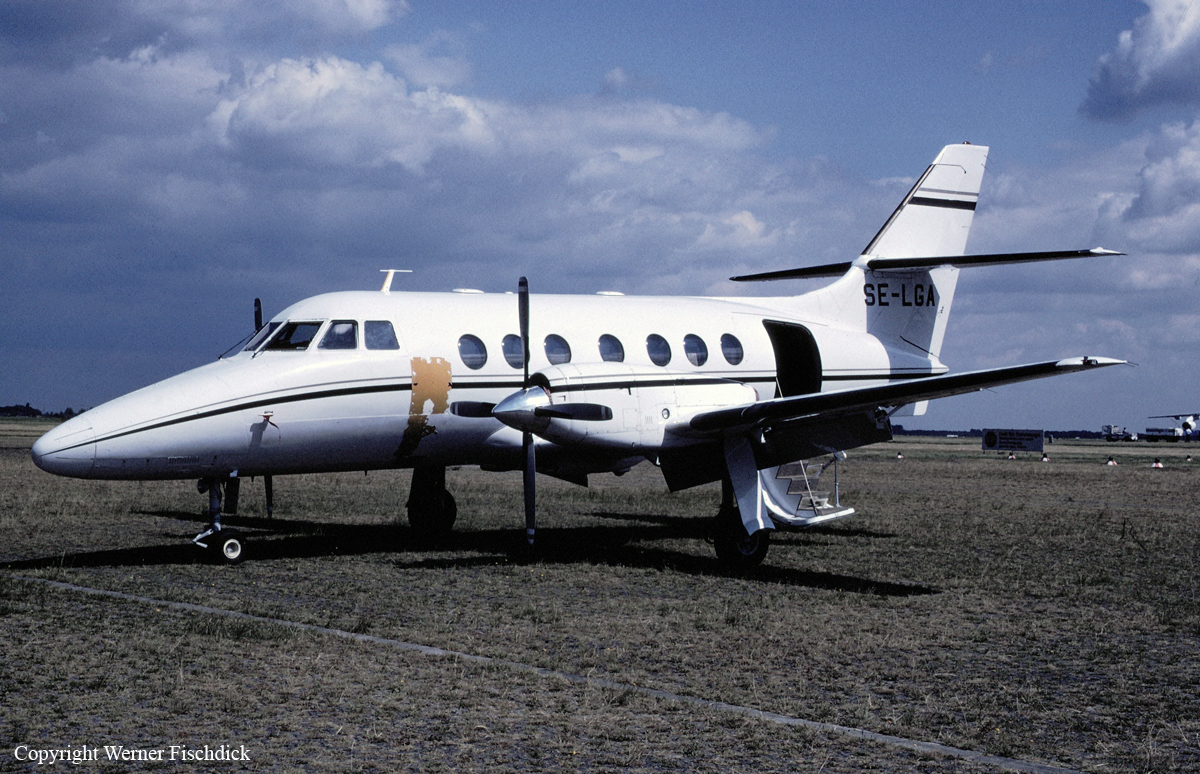

Crash of an Extra EA-400 in Rørvik
Date & Time:
Sep 2, 2001 at 1050 LT
Registration:
D-ETAW
Survivors:
Yes
Schedule:
Rørvik - Nuremberg
MSN:
08
YOM:
2000
Crew on board:
1
Crew fatalities:
Pax on board:
2
Pax fatalities:
Other fatalities:
Total fatalities:
0
Captain / Total hours on type:
50.00
Aircraft flight hours:
248
Aircraft flight cycles:
215
Circumstances:
The pilot went through the checklist “BEFORE STARTING ENGINE CHECKLIST” and then started the engine. Everything was normal and, after going through the subsequent points on the checklist, he taxied out to the end of runway 04 where he performed the “BEFORE TAKEOFF CHECK”. In the position at the end of the runway, an engine check was carried out. All was set at 10:50 hrs. As the accident happened outside opening hours, the Airport was unmanned and no AFIS or recovery services were available. The pilot held the aircraft back on brakes and gave “full power”. All indications were normal, according to the pilot. All the instruments indicated “high power”. He released the brakes and checked the acceleration. At 50% of the runway’s length, the passenger in the right front seat called an airspeed of 60 kts IAS, and at 75% of the runway, the pilot rotated the aircraft. At that point the speed was 78 kts. The pilot estimates that the aircraft had gained a height of approx. 25 m when he experienced a loss of power (“leistungsverlust”), which he thought was related to a loss of turbo power, shortly after the stall warning light came on. The pilot realized that it was impossible to continue the flight, so he attempted to land on the remaining runway. 150 m of the runway still remained, and the aircraft landed hard at a steep angle on the runway. The aircraft hit the runway hard on the main wheels and the tail. When the pilot realized that it would be difficult to stop on the remaining portion of the runway, he retracted the landing gear. The aircraft continued past the end of the runway, where it hit several large rocks along the breakwater, where the approach lights for runway 04 are positioned. Following hitting the rocks, the pilot registered fire in the engine, which was quickly extinguished when the aircraft entered the water along the breakwater. The left wing hit so hard into the breakwater that the aircraft rotated 180° and stopped in the opposite direction of the take-off. The aircraft half filled with water immediately. The passengers and pilot unfastened their seat belts and evacuated through the emergency hatch on the right-hand side of the aircraft. The passenger seated in the cabin received only minor injuries during the evacuation, mainly caused by the jagged rocks.
Probable cause:
The AAIB/N’s investigations, in cooperation with an expert from the engine manufacturer, conclude that the experienced loss of engine power was caused by the grounding of one of the magnetos as a result of fire. The fire started when fuel began to leak from the fuel manifold valve and from there sprayed out over the engine’s crank casing, wires, pipes etc. Thereafter it is most probable that alternator no. 2 ignited the fuel. The fire spread rapidly and the insulation around the first magneto and subsequently the second were destroyed with the result that they became permanently connected to ground. This first led to the engine losing power and then failing altogether. The blue staining of the crankcase’s top and the presence of yellow putty indicate that this loose connection dates from the time after the engine’s shock loading inspection, following the gear up landing approx. 175 hrs previous to the accident. During this inspection the fuel manifold valve and fuel pipes were dismantled and reinstalled. Presumably the leakage started gradually. Initially the extent of the leakage might have been so minor that the fuel had vaporized without being set alight. The blue staining of the cylinders conveys that there have been pools of fuel in the area, and that significant leakage undoubtedly occurred during the flight from Germany to Norway. On start-up from Rørvik Airport Ryum, the leakage continued and it is most probable that the fire started just before take-off. The pilot did not observe the fire before he hit the large stones at the end of the runway, i.e. shortly before the aircraft continued out into the sea. This is explained by the engine cowling being unusually tight fitted on this liquid-cooled engine aircraft. The flames could not be seen before the engine cowling was struck sideways in the crash. The sea extinguished the fire immediately.
Final Report:






